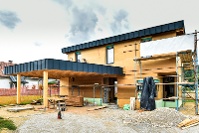 According to a report issued by the National Oceanic and Atmospheric Administration (NOAA) this week, 2021 was the sixth warmest year on record.[1] Further, the hottest decade ever recorded occurred between 2009 and 2019.[2] The planet’s warming trend is forcing home builders globally to get creative to address the challenges we’re confronting. Here are five ways the climate is reshaping housing.
According to a report issued by the National Oceanic and Atmospheric Administration (NOAA) this week, 2021 was the sixth warmest year on record.[1] Further, the hottest decade ever recorded occurred between 2009 and 2019.[2] The planet’s warming trend is forcing home builders globally to get creative to address the challenges we’re confronting. Here are five ways the climate is reshaping housing.
More Sustainable, Efficient, Resilient
Improving building energy efficiency codes is great, but we also need to create new ways to strengthen and fortify homes to withstand climate change. According to a report from Earth Talk, a non-profit organization that reports on climate issues, incorporating sustainability (recycled content), resiliency, and efficiency are ideal in the evolution of new home construction. Specifically, it notes that new forms of concrete made from recycled or waste-based materials can save a large share of the carbon emissions generated by constructing residential buildings, which accounts for 17 percent of global carbon emissions.
In addition, tighter building envelopes and strategically placed windows that allow for passive solar heating will reduce heating bills and energy demand.
Super Insulation, Please
No, you’re not imagining that passive house was everywhere in 2021. The super insulation of passive house technology will only gain in popularity as the need to have more resilient, less energy-intensive buildings accelerates.
More builders are seeking Passive House certification and in more types of construction than ever before. One example is the PHIUS-certified 42 Broad Street project, a 16-story, 249-unit residential tower in Mount Vernon, NY.
Cooler Roofs
Did you know that according to the DOE, painting a roof white or another light color enables it to reflect solar radiation and keep a building up to 50 degrees cooler than a typical roof on a hot day? Simple ideas like lighter roof tiles are easy changes that can help reduce heat and energy use, and scientists are working daily on other technologies. Lawrence Berkeley Lab engineers have developed a roof coating that can keep a building warmer or cooler depending on the weather.[3]
Eco-Friendly Innovations and High-Density
In an October interview with Peggy Smedley, an expert in the Internet of Things (IoT), we reported that smart technology will drive sustainable homes of the future. Technology that links appliances, lights, and other electrical devices and optimizes energy use will be critical in making new homes as energy-efficient and water-efficient as possible, which will be necessary as the climate changes.
Moreover, geographic placement is becoming more critical. Optimizing residential construction for high-density and abundant transportation options, including bus and rail lines, is already happening and will only accelerate in the future.
Extreme Innovation
The ramifications of climate change pose significant challenges for nations at high risk of flooding, like the Netherlands. As such, the country is pioneering floating homes, which are anchored tightly to the shore but can rise and fall with the tide, according to Earth Talk.
Why it Matters
Sustainability, adaptability, and resiliency are central to most nations’ efforts to adapt to climate change. Significant challenges require forward-thinking solutions. Builders are increasingly leveraging smart solutions in new home construction as climate change increases the urgency of that effort.
[2] https://www.climatecentral.org/gallery/graphics/top-10-warmest-years-on-record
[3] https://newatlas.com/materials/tarc-roof-coating-adaptive-heating-cooling/





